Content Marketing Framework: Story
Developing the content in our content marketing strategy is developing the stories of us. It’s the big ideas that we represent. It’s the differentiated experiences we want to create. It’s what we REALLY do for a living. For better or worse — it’s that simple.
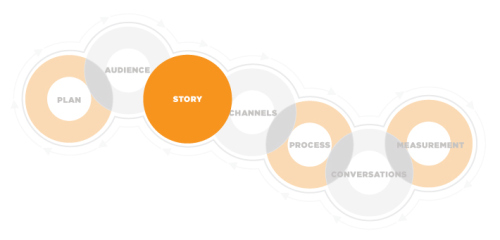
Storytelling is not intended to be a “selling” tool; it’s a method of building strong relationships with your customers and a thriving community of loyalists over time.
Your story identifies what your passions are and serves as the foundation for all your future content developments. One way to uncover your company’s “story” is through our Brand Hero’s Journey Chart . The chart can help you develop a structure that can be used across one small content marketing initiative — or across an entire strategy of content marketing throughout your company.
Here are some additional posts that can help you craft your organization’s story:
-
5 Brand Storytelling Lessons We Can Learn from Facebook Stories
-
Developing Your Pillars of Content with Robert Rose [Interview]

Story is the third step in building a successful content marketing strategy. Download our white paper, The CMI Content Marketing Framework: 7 Building Blocks to Success for an overview of the process, or learn about the other steps with our how-to guides on the right-hand side of the page.
Brand Storytelling: 10 Steps to Start Your Content Marketing Hero’s Journey
As a content marketer, you have probably heard the call for us all to become brand storytellers . While this sounds great in theory, the tricky part for many companies is determining how to develop these stories in the first place.
There are no hard-and-fast rules for developing your brand’s stories, but you can go back and look at classic storytelling and structure as a helpful map to guide you. For example, the classic “hero’s journey” from Joseph Campbell’s, The Hero with a Thousand Faces , outlines what he calls the “monomyth” — which is a pattern that many believe can be found in almost every narrative around the world.
Campbell’s point is that storytelling across time shares a fundamental structure and can be summarized into this journey. Later, in 1992, screenwriter and story consultant Christopher Vogler took Campbell’s structure, modernized it for today’s audiences, and reduced it to 12 stages in his book, The Writer’s Journey: Mythic Structure for Storytellers . This made the stages much more approachable for today’s writers — and is now mandatory reading for any novel or screenwriter. Vogler’s hero’s journey is this:
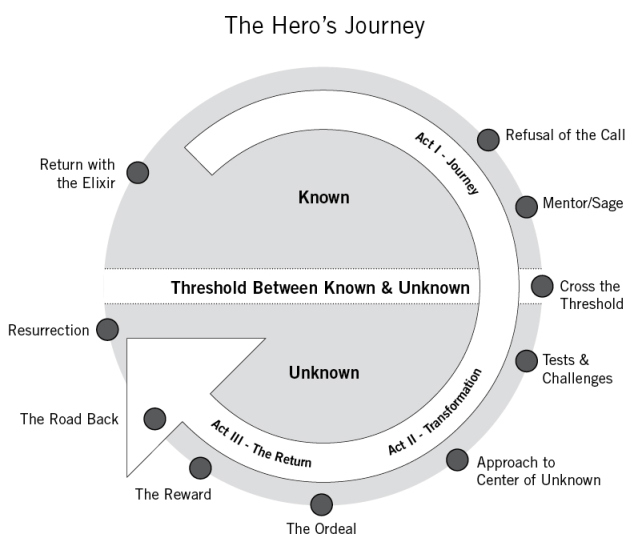
There are ways to use this hero’s journey to develop your own pillars of content — your own stories. In Managing Content Marketing , Joe and I reduced Vogler’s stages to 10 steps for developing your content marketing brand journey. But before I jump in to explain those 10 steps, know that this is just a framework, not a “to-do” list or a template. The structure is meant to provide a platform to help you to develop a way to tell your story, or maybe to discover what’s missing from your existing story. It’s not a template for the story — this is an important distinction, because your story will be unique to you, your brand, and the experience you are trying to create.

Step 1: The conventional market
This is your brand’s world — and as you brainstorm your pillars of content, you should know and be able to define the conventional:
-
What does your market look like?
-
Where are your competitors situated?
-
Why do they currently identify with your brand?
Step 2: The challenge
This is your big “W hat if? “:
-
What if XYZ were actually true?
-
What would the world look like if you could actually realize that “Big Hairy Audacious Goal” (BHAG) that you’ve set out for your brand?
-
What is the call to adventure for your product?
-
What’s the big promise?
-
Why hasn’t this been done?
-
Why haven’t you done it yet?
-
What’s the pain that the conventional market feels now?
-
What will you need to add to your story to let your audience know what will be left behind?
-
Are you conflicted about this?
-
What will be the effect of this change on your existing brand?
-
Who in your company (or outside of it) can help you take this adventure?
-
Who will provide guidance for your brand as it makes this journey? Is it you? Is it your CEO? Or, do you even have that person? Is it more than one person? Can you get someone external for this?
-
Will you need to conjure an imaginary character to act as your sage or mentor?
-
Who can stand in front of the world and credibly tell your audience that you are going on this journey together?
Step 3: The rejection of the challenge
Step 4: Appointment of the sage
Step 5: Crossing into the unfamiliar
This is where you burn the ships so that you can’t go back. Ultimately, in your content marketing, your brand must take a definitive point of view that is differentiated — and it will cross into your new “ what if? ” idea. This is the unknown — and it’s what you are exploring:
-
How will you communicate this crossing into this new idea — this new adventure?
-
How will you lead your audience into this new unknown with you?
Step 6: Map the road of challenges
Part of this step is unknown to you as an author, but you can use it to determine how you’ll gather friends. Or maybe you’ll take a strong point of view that may actually create enemies, or controversy:
-
Who will your brand align with?
-
How can they help you move forward?
-
What tests to your brand’s legitimacy will it face in the unknown?
-
Who will be the naysayers?
-
What tests and challenges can you plan for?
-
What skills will your brand need to address?
Step 7: The final challenge
As your brand faces these challenges, attracts and aligns with friends, and establishes a differentiated point of view, it should establish itself as differentiated — as a leader:
-
What will it ultimately achieve?
-
What learned skills (or attributes) will your organization take into the final challenge?
-
What will that final challenge be?
This is the culmination of your brand story. In the larger sense, you may never want your brand’s (your hero’s) story to end. And this content marketing campaign may be but one episode in your story. But this final challenge is what you have to overcome to get to the possibility of the “ what if? “…
Step 8: Looking back
Take a look back at the ordinary world. Your brand is different now. How do you show that differentiation?
Step 9: The final renewal
Your brand’s story is never going to end, and you are now ready to continue on your journey. But you may encounter new, formidable challenges now that you are a changed entity:
-
What ambush could — or will — your brand face now that it is different?
-
What will the competition say about you now — and how do you continue?
Step 10: The celebration
This is you realizing the dream. Celebrating. It’s the final part of your story.
There you have it — the structure. It can be used across one small content marketing initiative — or across an entire strategy of content marketing across the enterprise. Changing the level of hero from product, to brand, to service can make it more interesting, and enables you to explore ever more creative “webs” of stories among them.
This story structure — which is inherently linear — can also help you structure your content into a story map. The story map helps to organize your pieces of content across a timeline. It compels you to think of your content pieces as “chapters” or “scenes,” and can help reveal the gaps. It may resemble a high-level editorial calendar — but is structured with a focus on telling your complete brand story as you continue along your content development process.
Want to learn more about brand storytelling? Catch Robert Rose’s workshop, “Content Marketing 201: Building Stories that Sell” at Content Marketing World Sydney on March 4. To register for the event, use promo code CMI200 to save $200 when registering (Note: The workshop has an additional cost.)
Brand Storytelling: Why Words Matter as Much as Design
As important as a captivating design is to your content marketing, stories (and the words that tell them) are what make people decide if they like you, if you understand their needs, and if they want to do business with you. Brand storytelling can’t be done with visuals alone.
While great design might lure someone in, it’s not enough to sustain a real relationship. People communicate through conversation, and the words are essential to that dialogue.
Imagine if you were planning a wine tasting trip in Napa and you found beautiful pictures of vineyards but no descriptions of the types of wines they offer, or the notes or history of the grapes? What if you were searching for a new camera and just found visuals of cameras, with no information on features, and no product reviews? Words matter, and brands that tell their stories — not just show them — win.
Words are powerful
Words spark emotion and transport people into a different mindset. A great example of this is seen in a video that went viral in 2011 called, “The Power of Words.” It shows a blind, homeless man sitting on a city street collecting change. Initially he held up a sign that simply said, “ I’m blind, please help. ” The video shows most people just glancing and walking by. The turning point comes when a woman stopped and rewrote his sign to say, “ It’s a beautiful day and I can’t see it. ”
Why do these new words become impossible to ignore? They forge an emotional connection between the experience of one person and another. They make the passersby relate in an entirely different way to what and whom they see. This short film illustrates how the power of words can dramatically change your message and effect upon people.
Words on the web
According to Google ZMOT, in 2011 people researched and digested 10.4 unique pieces of content before making a purchasing decision. If the internet was made up of only visuals and pretty designs, would it be any use? Your online content is the voice of your company, speaking to your customers and telling your story while you’re busy growing your business.
Words make the web work. We live in a time when most people instantly search online before making a purchasing decision. When you want to find information on something what do you do? You search online, sometimes over and over again, until you have a good idea about what you want and who you want it from.
So many companies focus on the visual side of their story and neglect the importance of the words. They put all of their efforts into the look and design of a website without carving out a carefully crafted message that speaks to their audience. At my company ( Sprout Content ), we often talk with clients who “want a new website,” but haven’t given any thought to what it will say or who they are saying it to. They’re neglecting brand storytelling. Businesses often work with web developers to create a new site, but lack of content holds up the entire process.
Visuals and words telling a story
We’ve seen that many companies often don’t understand their story or how it can be told to clients and prospects. If you’re selling a traditionally “ boring ” product or service (think accounting, or carpet cleaning), words can actually paint an exciting and interesting picture of your business and products.
Think your business isn’t that exciting? Paper converting likely doesn’t sound thrilling either — until the company’s story is told:
Oren International (full disclosure: It is a client) is a paper-converting company that had an outdated website that did not communicate its scope of services or, more importantly, what the company is passionate about. It offered basic square swatches of products — all of the content included factual information, such as a list of dimensions.
We worked with Oren to create new content that explains how it partners with companies to bring their visions to life and convey their passion for paper. It has a voice and perspective and effectively communicates what Oren can do and what all of its products are used for.
Words and visuals must work as a cohesive and complete team to paint the full picture of a brand story. Your package design, website, blog theme, catalogue, or brochure might be drop-dead gorgeous, but if the words in it aren’t compelling, no one will keep reading. When the design is interesting, all of your words create a more powerful experience. On the flipside, if the design is bad, your brilliant words will go unread and your story untold.
Data-Driven Brand Storytelling: 6 Steps to a Credible Story
SHow much more compelling would your brand storytelling be if data were the focus of your content strategy?
In a recent article published here on CMI, Colleen Jones asked the question, “Can digital branded content ever be taken seriously — even as seriously as journalism?”
Without a doubt journalism has had a huge head start when it comes to creating stories that capture hearts and minds. Part of that success comes from using research data (polls, surveys and feedback) to understand what readers find valuable, particularly as it relates to the issues and problems they face.
Do content marketers have the same research opportunities? Of course they do. In fact, if more content marketers were to use publicly available data the way journalists do then branded content would offer new angles, insights, and more value to stories that affect people’s lives.
But the good news, as Colleen explains, is that, “Americans are quite open to brands being credible sources of web content.” One way for brands to increase content credibility is to introduce trustworthy third-party data as part of their stories. Credible stories are rooted in something that’s real, not just your ideas. So for example data, research and numbers can be the foundation of the story, while your ideas and opinions add perspective to the story.
Currently, there are mountains of data available, on the internet and elsewhere, that organizations can use to develop credible stories that are infused with insight, relevance, and inspiration. So how can your brand learn to create data-driven stories? Here is a six-point process for brand storytelling that you can use to get started:
#1. Keep your audience top of mind
Great data-driven stories start with great questions — specifically, questions that are relevant to your audience and customers, such as what are their nagging questions, or what are their greatest business challenges? If the questions you come up with have quantifiable dimension, chances are they will make for a good data-driven story.
For example, let’s say you’re in the health care space, and you know your audience is concerned with finding accurate, reliable health information online. One story you can consider creating would be a piece on how patients use online health care records in your city, and how often they access this information. The specific question your content might address here would look like this: “ Why consumer demand of health IT outstrips supply .”
#2. Find the data
Once you have defined a question on which to base your content, you need to determine the available data records you can incorporate to answer that question. To do this, you will need to think about the process you will use to collect, filter, and visualize data in order to create deeper insights that will inform your story.
Collect: At first when you’re looking for data on a particular topic or issue, you may not know where to look, or if that data even exists.
However, if the problem has a measurable component, there’s a good chance of finding adequate data (on the internet) to generate an insightful answer. Finding adequate data to support your answer is important because you don’t want to jump into a data-driven story that cannot be executed.
Using the health care example above, you would need to find data that shows how many patients have asked for their health records online, how many doctors or facilities have the technology to furnish such requests, how many have actually done so, etc. Here are some good places to start looking for this data:
-
Public data sites, e.g., government databases or state agency databases
-
General lists, such as the Journalists Toolbox or Freebase — an interesting Google subsidiary that provides entity graphs of people, places, and things
-
Q&A sites, such as Get the Data or Quora — a site where you can post your data-related questions (including where to find data on a particular issue)
#3. Vet your data source, and filter your findings
Don’t forget that the goal of using data is to increase your content’s credibility and to validate your brand’s storytelling. That said, make sure that the source of your data is also credible. Use sources that are reputable and well known for research data; for example, Forrester Research and Pew Research .
Generally speaking, academic journals, university sites, studies, and research reports from professional institutes are good sources of data, while most blogs (unless they’re very authoritative) are not.
Filtering data is like interviewing a real source. You ask specific questions in order to get the answers you’re looking for. Same thing with data — what question do you want the data to answer?
Let’s say you’re writing a story about hospital closures in your county. The data-backed statements you will make will involve the number of hospitals registered, how much it costs to keep them running, sources of funding including how many people with health insurance, etc. So the minimum data you would need to filter is number of hospitals, cost, revenue, number of insured, etc.
#4. Choose a visual representation
Our attention-deficient generation gravitates toward visual content. So once you have found adequate data, and have determined which of the available data will best address your initial question and strengthen your story, you then have to think about how you will represent it visually for your audience’s consumption. For example, bar charts, pie charts, infographics, and mappings are all simple methods of data visualization, so you will need to decide which format will work best for the data you are using.
For example, check out this innovative visual from GE Healthcare, which captures ”Who’s talking about breast cancer” on Twitter.
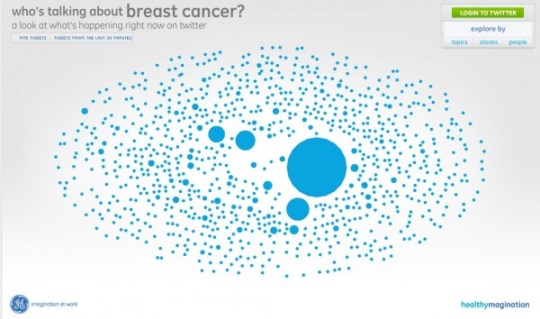
http://visualization.geblogs.com/visualization/cancerconversation/
Remember that the more interesting the visualization, the more time and attention consumers will give it. Be sure to keep your visualizations simple — you don’t want to make your audience have to work hard to figure what your graph is all about. Try several different visuals and see what appeals to your audience, then stick with that format.
You can go online and check out various free visualization tools that enable storytelling with data , such as Google Fusion , Tableau , Visual.ly , and others.
#5. Shape the story
Using data is about adding as much value to your content as possible. It’s about saying something that hasn’t been said before. As you begin to shape your story, try to use an original approach and be sure to add a unique and meaningful perspective.
More often than not, a successful data-driven story will require the collaboration of analytical-types (to gather, analyze, filter and visualize data) and creative types to unearth a compelling story that’s just waiting to be told.
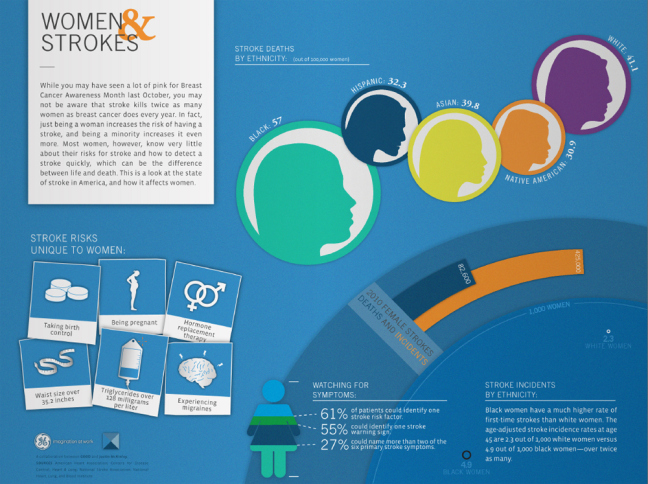
This is a great example of a data-driven story by GE Healthcare.
#6. Get some feedback before launching
When you’re finished, show your story to an outsider who has absolutely no connection to the project. Ask them what they think. Does it make sense? Is it interesting, or just confusing? Take that constructive feedback and use it to peel away the layers that don’t add value to the story.
You may have to simplify the data or the visual, or find different words to tell the story (or, God-forbid, all of the above!). This may take more time, but it’s important — it could mean winning the hearts and minds of your audience, or losing them altogether.
Over to you: Has your organization experimented with data-driven stories? How did you approach the project? Please share your ideas in the comment box below.
Create your personas
One of the tenets of content marketing is that you need to understand — and write specifically — for your audience. To help you do this, it’s essential to create your personas:
-
An In-Depth Look at How to Create and Use B2B Buyer Personas with Ardath Albee
-
Put the Person Back in Content Marketing Personas: 10 Easy Steps
Remember your influencers
You may think buyer persona = customer, but there are other influencers you need to consider as well. This short video featuring Amanda Maksymiw , Leslie Reiser , and Waynette Tubbs reminds us that you need to have a plan for reaching industry thought leaders, those within your organization and customers.
Brand Marketer Interview – Influencer Marketing Strategy Tips from Content Marketing Institute on Vimeo .
Here are some other informative posts on influencer marketing:
-
Win at Content Marketing by Building Your Influencer Community
-
For Influential Content Marketing, Go Beyond Your Brand Fans
-
How a New “Influencer” App Could Be Your Most Powerful Content Marketing Weapon
-
Content Marketing Strategy: How to Engage Influencers in Your Industry
Want to bring all of this together? A content segmentation grid helps you build a high-level view of your different audiences, what content you have that meets their needs, and where your gaps are after your personas have been developed. Use this as a way to understand not only what you’ve developed so far, but where you’ll need to spend the most time as you begin to put your content marketing plans into action.
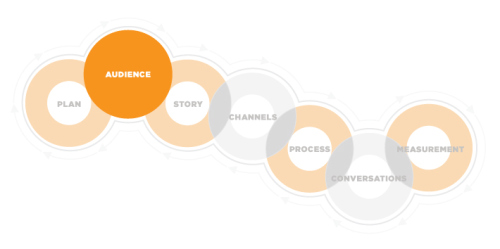
A Quick and Dirty Way to Segment your B2B Content Marketing
If you’re a B2B marketer you’ve inevitably heard sales say things like this:
“Yeah, we’re getting leads from all that content you guys in marketing are writing – but they’re all tire kickers.” Or (my favorite): “We don’t need more leads. . . we need better leads.” What now?
You want to be able to address these questions from sales with answers that are really specific. For instance, wouldn’t it be nice to be armed with this kind of info?
-
What kind of leads is Google PPC (or any tactic I’m tracking) delivering? Are they early tire kickers or last-minute shoppers?
-
At what stage in the funnel are most of my content marketing leads dropping in?
-
Which content is resonating best with what part of the funnel? For example, is my “How-To Guide” being used more at the beginning of the buying cycle – or rather to justify putting our company on the short list?
How do you get the answers to these questions? Map your content to your buyer personas by sales stages.
While you can—and at some point should—go through a more comprehensive content mapping and segmentation exercise, this two-part post promises a quick and dirty strategy. Done well, this process–which shouldn’t take more than a couple of hours–will give you an extraordinarily effective and quick method to answer these questions and look like a content marketing genius to your boss or your client.
This first post walks you through how to map your content to the the buyer persona and the sales cycle. The follow up post will give you tips on how to use this content map to plan for additional content and measure what is and isn’t working so you can answer those questions for sales.
Step 1: Develop buyer personas
Before you get started, you need to have buyer personas. If you are looking for more specifics on buyer personas , there have already been a couple of posts on the Content Marketing Institute that dug into the specifics: Keith Wiegold had a post about thinking about more than demographics and yesterday Chris Moritz provides some good links to get more info. You can also check out some great resources at Savvy B2B Marketing and at David Meerman Scott’s web site .
You need one persona for every group you are marketing to. For instance, if you’re in charge of marketing for a technology company and your Widget-Integration-Management-Program (or WIMP) Solution is marketed to the Director of IT and the CFO at financial service companies, you would have two WIMP buyer personas: a Director of IT at a Regional Bank, and the CFO at that bank.
Step 2: Understand your sales funnel
You’ll also want to have your sales team’s funnel handy. These are the stages that a lead goes through on its way to being a customer. It will look something like this:
Raw Lead > Opportunity > Qualified Prospect > Customer
Step 3: Build your content segmentation grid
Now, let’s build your content segmentation grid. You’ll do this along two axes. The first axis is the personas, and the second is your sales funnel.
For this exercise we’re going to assume that once your persona is a customer, you stop marketing to them. This isn’t something I would recommend, and there’s a whole other set of fun exercises to go through for that. But that’s for a different post.
Once you have your grid, start filling in the cells. What goes in the cells? Well, that’s where you start identifying your inventory of content. So your grid might ultimately look something like this:
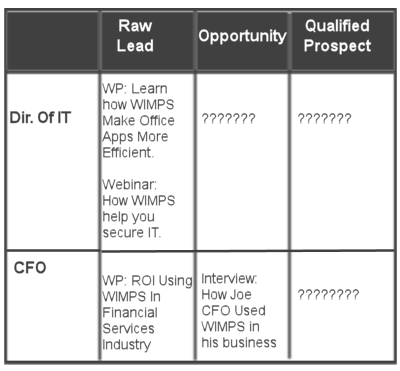
One thing you may notice in this example is that most of our content marketing is focused at the top of the funnel. This is almost universally common, so don’t worry if this is true for you as well. We almost always start a B2B content marketing strategy by focusing on awareness and education, which is almost inevitably at the top of the funnel.
One benefit of this exercise is that it very often points out that your content marketing is either very light or very heavy on one stage or one persona.
Once you are armed with your content segmentation grid, you are ready to start developing content and measuring what is and isn’t working. I’ll take you through those steps in my next post. Stay tuned.
For Influential Content Marketing, Go Beyond Your Brand Fans
At most of the events I attend, I rarely get to see other people speak. Often, I’m shuttled in to do a keynote or workshop, and then quickly leave for the next event. Last week was different. I had the pleasure of seeing Scott Stratten ( @unmarketing ) speak at the 2012 DMA Annual Conference . Scott has it right: The first rule of speaking is to entertain… then you can try to cover all that educational stuff.
Based on his presentation alone, I bought his new book (and I rarely buy books) entitled The Book of Business Awesome . Frankly, I probably would have purchased the book based on the title alone (great title!).
Connecting with the “Third Circle”
In the book (which is more of a customer service book than a content marketing book), Stratten wrote a chapter that discusses the “Three Circles of Content Sharing.”
-
The First Circle: These are the connections that are closest to us — and the strongest. These are people who share our content simply because they know and trust us. You can think of these people as our “brand fans”.
-
The Second Circle: These are the friends of those in your first circle. They see our content on a regular basis because our first circle connections share it.
-
The Third Circle: These are the connections of your second circle — ultimately the most valuable if you are seeking maximum content reach.
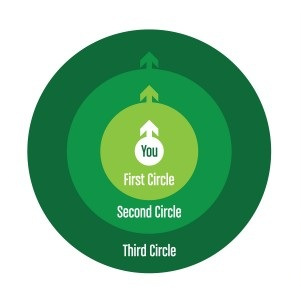
http://johnmichaelmorgan.com/5-burning-questions-with-scott-stratten/
According to the third circle theory, there are some rules to understand and live by:
-
Your first circle will share anything because they are blinded by their love for you, so you can’t put a lot of weight into what this group shares.
-
The second circle is where most brands fall down with their content. Just one or two bad impressions of your content from those in your first circle, and you’ll lose them forever. This means that your content must be truly great to keep them interested. The second circle will initially look at your content solely based on their connection with the people in your first circle. Once you get them to open the content, it’s up to you to keep them engaged.
-
The holy grail lies in the third circle. According to Stratten, “…this is the group you need to be thinking about when you’re creating content.” If you reach the third circle, they most likely have no prior connection to your brand in any way. If the third circle shares your content, they will do it solely because it is amazing information that they feel is worthy of being shared.
Three keys to making it to the third circle
-
Focus on slow and steady progress: The big content hit (like Dollar Shave Club — see below) is extraordinarily rare. Normally, viral content hits happen after a slow, continuous stream of awesome content. For example, my Coca-Cola Content 2020 blog post has been seen by over 100,000 unique visitors (lots of sharing by the third circle). But it wasn’t immediate — this success happened after over 500 pieces of regularly-scheduled content were also published.
-
Capture (and captivate) your first circle: So many brands worry about their followers on social networks like Twitter and Facebook. Of course, those are great, but reaching the third circle should start with email . I’m amazed by the number of blogs and pieces of web content that don’t have “getting the email address” as a primary purpose of the blog. At a recent conference, DJ Waldow and I were discussing how many misconceptions exist about email and social sharing. Here’s the point: Social sharing often starts and ends with email . So first get them to sign up to your offer, and then continuously send them the best information for your niche on the planet.
-
Become the leading information provider for your niche: When I give a speech to brand marketers, I often ask this: “ Who here has the goal of being the leading information provider for your buyers. ” Rarely do hands go up, and this is a big problem. Why should your customers and prospects engage in your content? Because it solves their pain points in some way. There are simply too many choices out there where they can avoid your content altogether. So, you have to set up the processes and talent internally and externally to make sure that your content is epic, mind-altering content. I honestly think most brands feel that mediocre content that can fill the social gaps is just fine.
“ Just fine ” will never get you beyond the first circle. Third circle content requires industry domination. At a minimum, set this as your goal, and then set out to make it happen.
Looking for more guidance influencer marketing? Download our toolkit, The Complete Guide to Influencer Marketing: Strategies, Templates & Tools , which walks you through a simple 10-step process and provides three customizable templates.
-
How to Create Visual Content with this Simple, Dirt Cheap Tool
-
Creating Engaging Content: 3 Calls to Action that Get Conversions
The Complete Guide to Influencer Marketing: Strategies, Templates & Tools
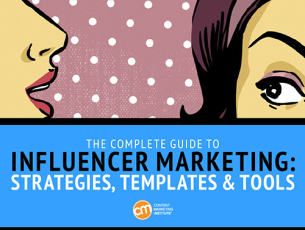
http://info.contentmarketinginstitute.com/acton/form/5141/0039:d-0001/1/index.htm
The practice of influencer marketing isn’t new. In fact, some may argue it’s one of the most long-standing marketing techniques around. But building a high-quality influencer program today—especially in the digital age—is no small feat.
We’re aiming to make it a bit easier for you with our latest eBook; The Complete Guide to Influencer Marketing: Strategies, Templates and Tools. Inside we’ve gathered industry-leading practices, insights from the experts and, you guessed it, codified templates and vetted tools to help you actually draft, execute and measure an influencer program—quickly. We’ve broken the process down into 10 straight-forward steps, so depending on where your marketing objectives, priorities and resources lie, you can use some or all of them as you build your program.
By downloading the eBook, you’ll also get access to three customizable templates that are described in the guide.
-
The CMI Content Marketing Framework: Understand what 7 building blocks are needed in your content marketing strategy.
-
2014 Content Marketing Research: Download our research reports that discuss content marketing benchmarks, budgets and trends in B2B, B2C, Australia, UK, enterprise and more.
-
58 Social Media Ideas for Content Marketing: See which social media channels are most popular, get ideas on how to use channel, and see examples of how brands are using each.
-
42 Hot Tips for Compelling Content Marketing: If you are new to content marketing or CMI, this post details the posts you don’t want to miss.